Why Do We Prune Deciduous Shrubs And Trees?
by Gil Medeiros, former Fairfax Master Gardener
If you can’t give a quick answer to the question in the title, you probably don’t prune enough — except for crape myrtles, which you may over-prune. Understanding the basics of pruning is a good first step toward taking better care of your trees and shrubs.
Dead, diseased or damaged
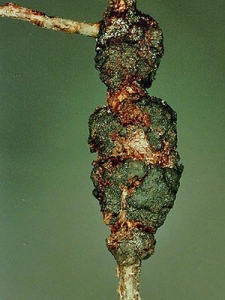
Black knot disease on a cherry tree will require pruning back to healthy wood.
Pruning is important to maintain the overall health of the plant. If a limb is dead, pruning removes a potential source of disease that may infect other parts of the plant. Likewise, if a limb is diseased, pruning removes the infected portion of the tree before the pathogen can spread to healthy areas. If a limb is damaged, pruning cleans up a ragged wound so that the tree can heal itself more easily. It is permissible to prune any time of the year when one of the three D’s is present—diseased, damaged or dead -— because the pruning will provide immediate benefits.
Trees heal wounds by creating an internal barrier or seal to prevent the spread of disease pathogens. Sealing is not free, however. The tree uses chemical and energy resources that would otherwise be devoted to new growth, reproduction and repelling insect pests and disease. Therefore, we do not want to make more cuts than necessary, and the cuts we make to remove dead wood must not damage the seal the tree has already made.
If you are pruning a limb that is already dead, make the pruning cut into dead material, leaving behind only a little bit of it. The reason for doing this is to avoid damaging the seal that the tree has already made between live and dead material. If you damage the seal, the tree has to synthesize chemicals to make a new one, and that is costly to the tree.
If you are pruning a diseased limb, always make the pruning cut in live and uninfected material. This often means going back a foot or more into live wood to locate the pruning cut. In this way, you are removing the disease pathogens before they can spread to the rest of the tree.
After making cuts, make sure to disinfect your pruning tools with rubbing alcohol, Listerine or Lysol (original formula). Lysol works best, but it is difficult to find on store shelves.
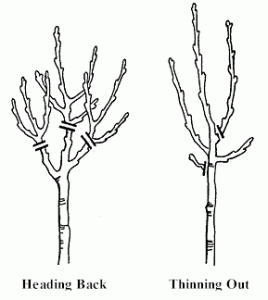
| Important Terms Thinning cut: Removing a branch or limb near the joint where it is connected to a larger branch or limb. This is always done just outside the collar or swelled area on the large branch or limb. Heading cut: Removing growth from a branch just above an outward facing node. This effectively shortens the branch, but produces dense growth near the cut. |
Preventive maintenance
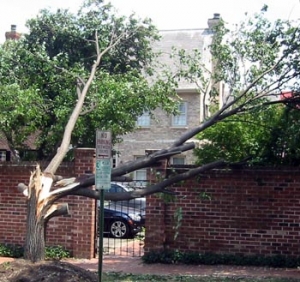
Wind damage to a Bradford pear tree. Proper pruning might have prevented the damage
People are often reluctant to prune an otherwise healthy plant because they fear that pruning will harm the plant. Indeed, it can harm the plant when the pruning is done improperly. However, when properly performed, pruning provides a number of benefits.
We normally wait until winter, when the tree or shrub is dormant, to do this type of pruning. We expect the plant to heal itself effectively during the spring when it is actively growing. There are exceptions to winter pruning. Spring-flowering trees and shrubs are usually pruned after the flowering period has ended.
Here are reasons to do preventive pruning:
- Prevent future damage by removing branches and limbs that are subject to breaking in snow, ice or strong wind. Trees and shrubs often grow limbs that exit the trunk at an acute angle of 45 degrees or less. Bradford pears are notorious for this. These joints between limb and trunk tend to be weak and easily broken. Remove these limbs just above the swelled collar at the intersection of the limb and trunk. It is best for the health of the tree if these pruning cuts can be done when the tree is young.
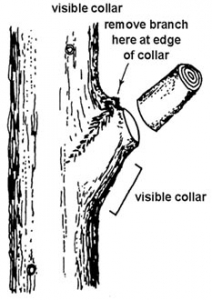
Proper removal of a limb, leaving behind the branch collar
- Prevent development of abrasion wounds by removing limbs that cross and rub against each other. When the tree is without leaves, examine the branches to find ones that cross.
- Improve air circulation to help prevent disease. Sometimes the growth of branches and foliage can become so dense that the air cannot move freely through the tree. This means it stays wet longer, and prolonged wetness on plants produces conditions where many diseases can take hold. Most trees and shrubs benefit from internal thinning; fruit trees benefit the most.
- Improve penetration of sunlight to allow health of lower branches. Leaves need sun. If the lower portions of the tree or shrub are completely shaded by the upper portions, the lower ones will die. Thinning cuts to allow penetration of sunlight are particularly important for shrubs such as boxwood.
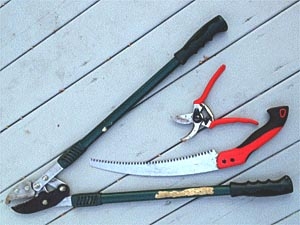 Gardeners use three basic tools to perform pruning. These are easy to obtain at any home center.
Gardeners use three basic tools to perform pruning. These are easy to obtain at any home center.
Hand pruners (right center): These are used to make cuts on limbs that are approximately the size of a pencil.
Lopping pruners: These have long handles and bigger jaws. They can be used to make cuts that are 1 to 2 inches in diameter, depending upon the size of the jaws.
Pruning saw: These little curved handsaws are useful for cuts up to 4 inches in diameter.
Improving appearance
Plants can become unsightly for a number of reasons. In many cases, you can save a plant by pruning it.
- Improve the shape and appearance of the plant. Trees and shrubs can grow asymmetrically or lopsided, to use perhaps a more descriptive word. To correct this condition, we make thinning cuts and sometimes heading cuts. This is both art and science. The science part is in knowing where to make a cut that will stimulate healthy new growth. The art part is making good aesthetic judgements to enhance the appearance of the tree.
- Stimulate new growth. Sometimes, you can rejuvenate an old shrub with hard pruning. This essentially means taking the whole thing down to within 6 inches of the ground and letting it grow new shoots from the roots. This is, in fact, called rejuvenation pruning. Another form of this pruning, called renewal pruning, removes only one-third of the old canes each year.
References
Pruning and Training, Christopher Brickell and David Joyce, American Horticultural Society, 2011
A Guide to Successful Pruning: Stop Topping Trees, Virginia Cooperative Extension
Pruning Trees, Clemson Cooperative Extension
…updated 2022